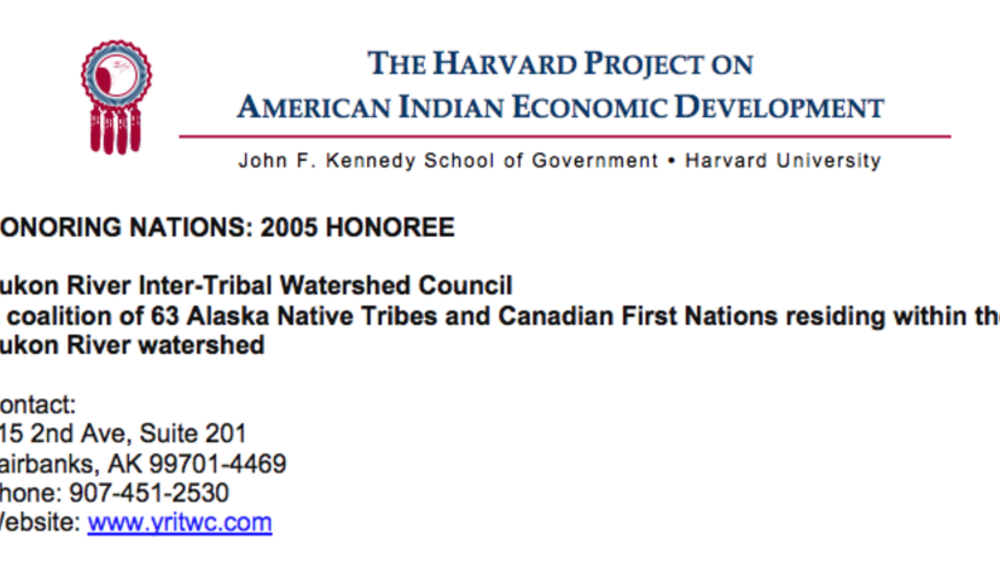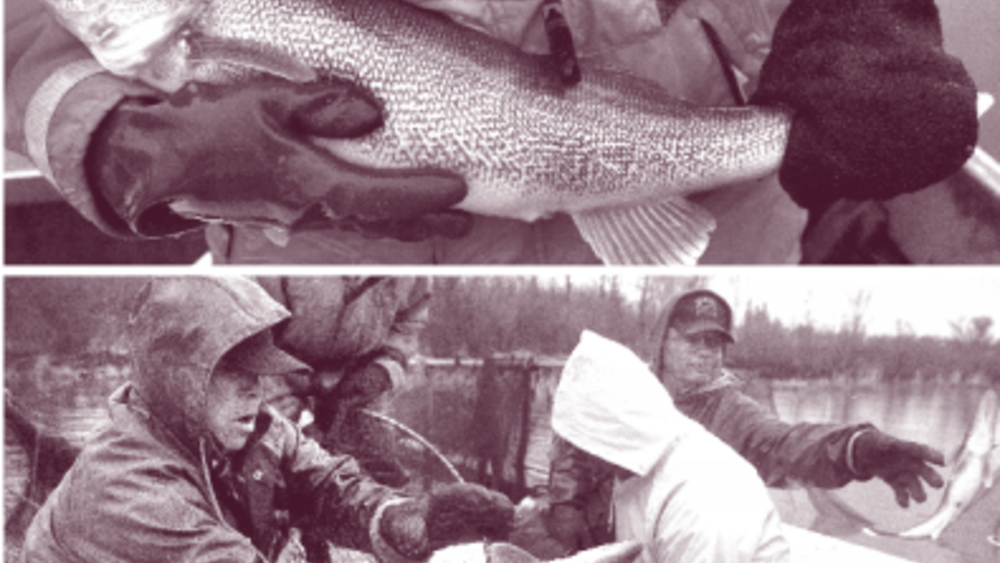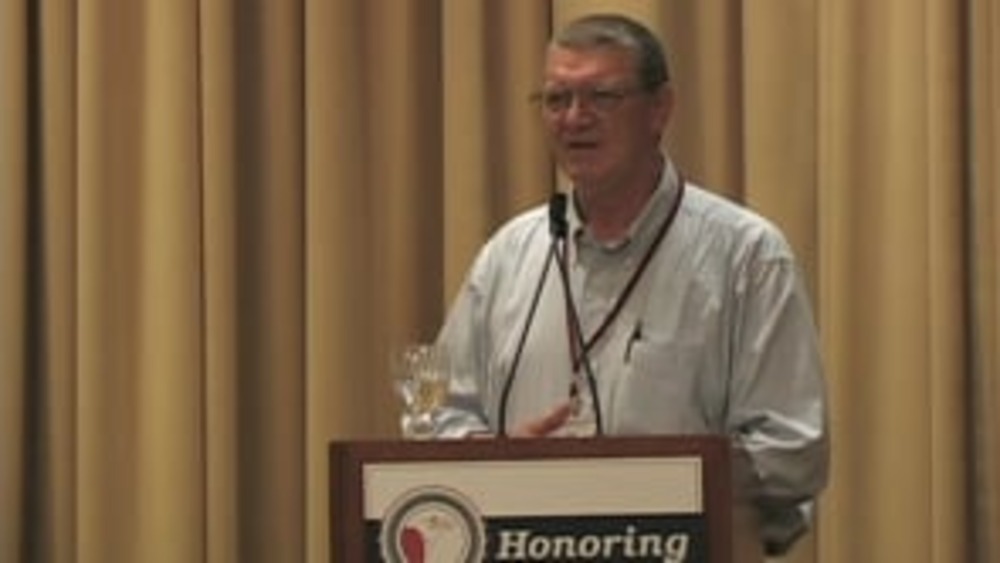Jon Waterhouse and Rob Rosenfeld provide an overview of the work accomplished by the Yukon River Inter-Tribal Watershed Council, demonstrating the benefits of Native nations who have common cultures and challenges to band together to solve issues of mutual concern.
Additional Information
Rosenfeld, Rob and Jon Waterhouse. "The Yukon River Inter-Tribal Watershed Council." Honoring Nations symposium. Harvard Project on American Indian Economic Development, John F. Kennedy School of Government, Harvard University. Cambridge, Massachusetts. September 27-28, 2007. Presentation.
Transcript
Heather Kendall-Miller:
"Our next panelist is Rob Rosenfeld, and he's going to be joined by Jon Waterhouse. Rob Rosenfeld is the Alaskan Region Director for the Yukon River Inter-Tribal Watershed Council. Their program is a 2005 honoree."
Jon Waterhouse:
"Good morning. My name's Jon Waterhouse and I work with the Yukon River Inter-Tribal Watershed Council. I'll start with a quick introduction. I'm S'Klallam, Chippewa, Cree and Scottish. I always kind of like to think I got the best parts. My wife has let me know that's my own private delusion. That's okay.
I would though, before we get going, I'd like to say this. We are a group of 66 Tribes and First Nations in the United States and Canada that came together in 1997. Now it's ten years later, you can imagine getting even five people together to agree on one thing. But the chiefs came together in '97 and decided that the Yukon River was in trouble and that it needed some help, and decided on one thing and that was clean water. And it's a unifier, I believe that to this day, and it has become that. As I heard earlier, nations around the world are having trouble getting together. I think as Native nations -- I agree with what I heard earlier -- that we can help them find some way to come together. If I could call on Heather Kendall-Miller, who has been a huge help, to come up here for just a minute. This is the part of the job I love. It's all-inclusive. That's what we try to be. We include everyone. I have a short mission statement I'd love to have her read for me."
Heather Kendall-Miller:
"Our Mission: We, the Indigenous Tribes/First Nations from the headwaters to the mouth of the Yukon River, having been placed here by our Creator, do hereby agree to initiate and continue the clean up and preservation of the Yukon River for the protection of our own and future generations of our Tribes/First Nations and for the continuation of our traditional Native way of life."
Jon Waterhouse:
"Okay, enough of the modern technology. Some of the issues of the day, that I've heard here today, are climate change and energy. Well, we've looked at a lot of programs -- I know the time is short. We have many programs, but on climate change we've taken water quality as one of our issues. The Yukon River is about 2,000 miles long. We have a program of water quality testing for the entire river system. It's been turned over to us by the USGS [U.S. Geological Survey], a world-renowned water quality group. And it's a capacity builder, because our tribal members of all 66 tribes are involved in that program. We've provided the training and now it's been taken to a whole new level where we are a world benchmark-river for climate change. All the scientists are looking at us. It's pretty exciting. All our programs are interwoven, so it's kind of hard to talk about one without talking about another. One of our hugely successful programs is the backhaul program, which kind of combines climate change and energy. The program cleans up things, so it kind of does something about climate change, and we take the materials and turn them into energy. In the last three years, we've removed five million pounds of recyclables and hazardous waste from the Yukon River watershed through a combination of private industry and public monies, like through our NGO [non-governmental organization]. It has taken airplanes, trains, boats, ships -- you name it -- but once again, it's a capacity builder. The tribes have taken this as their mission to clean up the watershed. It's a huge program. It can be replicated, and I offer that to everyone here, to take that home with them. It can be replicated around the world and I think it should. Some of the hazardous waste like the used oils that we've received from this program we've turned into energy. We found equipment, and helped design it, that combines the used oil on the molecular level with your existing heating fuel. It cleans the fuel; it's cleaner than anything you put in at the beginning. And we are now heating tribal offices and clinics with that fuel. So it's a pretty exciting program. Now I know time is short and I just wanted to tell you about a few of the programs that got us here. I'd like to turn the rest of this over to Rob Rosenfeld, who is not only an ally of ours, he is definitely one of our very good advisors. So, Rob Rosenfeld, please."
Rob Rosenfeld:
"Podiums are difficult for me as well; I am standing up. It is a true honor to be here among so many great nations. All great nations have allies and it's been a great honor for me to be an ally of Indigenous nations throughout the Yukon River Watershed and beyond.
Jon spoke briefly about the backhaul program. It's been a very, very exciting program. And the genesis of it was at the very first meeting of leaders in 1997. The leaders identified many of the different contaminant sources, from one end of the river to the other, including mining sites, military contaminants, but they looked mostly at their own municipal solid waste. And instead of pointing fingers at polluters, they decided to focus on what they could do in their own backyards. With that the backhaul program was created and, with one of the guiding principles of the organization, it was driven. Through inclusiveness, all the different backhaul companies, 12 airlines, three barge companies, two shipping companies, Alaska Railroad, as well as battery recycling companies joined together. They go out to the villages filled with all sorts of goods and services and come back empty. Not any more. They're loaded up to the gills. And we realized that they were going above and beyond and we realized the importance of rewarding them for their efforts and encouraging corporate responsibility.
And the way that we did that was -- actually, I'll give Jon Waterhouse the credit for that. I asked Jon to come up with a very creative way to say thank you to the many different transportation companies. He walked into my office one day with an idea to do a commercial on the Super Bowl. I thought he was nuts, actually. I had no idea that was even feasible. Well, within about six months, it came to reality. And Super Bowl Alaska aired a 60-second piece that focused on the good work of the transportation companies and the tribes. And that has now been shown two years in a row, last year twice at halftime.
And one of the things I wanted to focus on is, really, how the Honoring Nations award program has helped amplify the work of the Yukon River [Inter-Tribal] Watershed [Council]. Since the Honoring Nations Board of Directors acknowledged the good work of the Tribes on the Yukon River [Inter-Tribal] Watershed [Council], the organization has tripled in size and tripled in credibility. The money that came with the award was used for the video footage that was used for the Super Bowl commercial. It was also used for footage that was utilized to create a new documentary called Yukon Circles. That documentary is now part of the permanent archives of the National Museum of American [Indians]. It travels with the Wild and Scenic Film Festival all around the United States. It's showing in a film festival in Italy this next month in October, and it's been in nine other film festivals around the country.
I do want to switch for a moment to how not only Honoring Nations matters, but also unified voices of sovereign nations matters most of all. When 66 indigenous governments come together and take a position, that position is hard to ignore. It wasn't long ago, maybe three years ago, that the community of Galena was looking at and still is looking at a proposed nuclear reactor, being donated by Toshiba©. Now, it's kind of cute. It sounds kind of cute -- the 4S reactor. It's super, safe, small and simple. It sounds like you want to take it to bed with you. But it's actually 100 feet big; it's 60 feet in the ground and 40 feet above the ground. There's 450, or so, reactors in the world. Three of them are sodium cooled. Every single sodium-cooled reactor in the world that has ever gone online has gone on fire, blown up, and in one case killed everyone on site. Again, corporate America is looking to use Indigenous peoples as guinea pigs. And the Yukon River Inter-Tribal Watershed Council provided information to the Tribes and First Nations. It was a no brainer. It didn't take long. The Tribes and First Nations have unified and they oppose the transportation of radioactive materials on the Yukon River watershed, they stand against the storage of radioactive materials on the Yukon River watershed, the experimentation with Yukon radioactive materials on the watershed, and they opposed this particular sodium-cooled reactor. We got a phone call two nights ago from one of the city council members who once voted in favor of this proposed reactor who now, as of last night, took an official position against the reactor because he wanted to encourage all the city council members to recognize the desires of the First Nations and Tribes on the Yukon River watershed. So we hope next time to come back and let you know that there is no more talk of that reactor.
One other important thing that I wanted to mention was the unified voice that is starting to come to be with regards to a critical issue that affects all of us here in this room and beyond. There is a proposed land transfer in the Yukon Flats Wildlife Refuge, one of the biggest refuges in the United States. The Department of Interior is proposing trading some of the refuge land with a corporation. That would be the beginning of the erosion of refuges in the United States. To go along with that, in an area that has 80 percent unemployment in most places, Fish and Wildlife has put a high dollar -- and is proposing to put a high-dollar value -- on buying Native allotments. What it could amount to is yet another federal land grab of Native lands. I can say that from a meeting over three weeks ago or four weeks ago more than 50 Tribes and First Nations have expressed their opposition for this proposed land transfer. And we'll be going to Secretary Kempthorne's office in the very near future, hopefully, if he will honor the request for a meeting. And the request will be made to 'please, not to release a draft environmental impact statement without first consulting with all the governments, all the tribal governments on the Yukon River watershed,' before a draft environmental impact statement is released, so that their concerns can be integrated, rather than being reactionary to a position that gets put out. Finally, the leaders have requested a Senate Committee on Indian Affairs hearing to look at the impacts of military contaminants throughout the Yukon River watershed.
And I'll just close with sharing the theme of this initiative here today and this symposium, is sharing successes. And since the Yukon River Inter-Tribal Watershed Council received high honors in 2005, and received incredible exposure as a result, the leaders on the Yukon River [Inter-Tribal] Watershed [Council] have since been invited to go to Bolivia, Paraguay and Argentina to help the Indigenous governments form an inter-tribal watershed effort in a similar way. Since then they have gone already to the Salish Sea Conference, where 88 First Nations and Tribes came together to also emulate and take the best from this idea of organizing on a watershed basis, a paradigm shift. In addition, the leaders have been invited to Hungary, Romania, Bulgaria, the Czech Republic and Slovakia as those countries work together on cross-border environmental cooperation. Just three days ago, we spoke at a NAFTA [North American Free Trade Agreement] conference where the people of Mexico asked for the documentary to include subtitles in Spanish, so that the people of Mexico protecting their rivers can begin to learn from this effort and invitations have already been extended. We've learned of the Three Rivers effort in England, where now there's been invitations for leadership to go to England to teach how to organize for river watershed protection. And finally, there's been invitations to speak at French universities.
In any event, I'm just so honored to be here, and I look forward to getting to know folks, and continuing to learn from all your wisdom in this room. Thank you."



